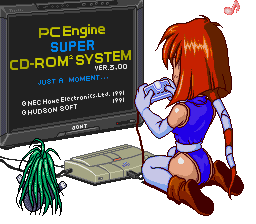I've uploaded the Ghouls N Ghosts ~ Daimakaimura ending music from the SATURN version from Capcom Generation vol 2, as well as the Arcade, Genesis and SuperGrafx versions.
in my honest opinion, they REALLY screwed up the ending music in the Saturn version -- whatever they did to it -- call it a remix, an arrangement, or what have you. I strongly dislike it. It's highly irritating.
even if it is technically advanced ( i'm not saying it is) I still really dislike this rendition...
I think the Genesis version of the ending music is FAR, FAR better as it reproduces the arcade much more nicely. The SuperGrafx version, well they kinda tried, concidering the limitations of the audio chip... it's not as good as the Genesis version. but these all make for an interesting comparison. I'll try to upload the Playstation / Xbox versions later.
note: I could only get 3 minutes each because that's what the trial version of the software I'm using allows. I have more robust audio recording software but it's way over my head and didn't have time to learn it. 3min for each version should be enough for you to get the idea.... i'm not even a novice at using software or computers...
in my honest opinion, they REALLY screwed up the ending music in the Saturn version -- whatever they did to it -- call it a remix, an arrangement, or what have you. I strongly dislike it. It's highly irritating.
even if it is technically advanced ( i'm not saying it is) I still really dislike this rendition...
I think the Genesis version of the ending music is FAR, FAR better as it reproduces the arcade much more nicely. The SuperGrafx version, well they kinda tried, concidering the limitations of the audio chip... it's not as good as the Genesis version. but these all make for an interesting comparison. I'll try to upload the Playstation / Xbox versions later.
note: I could only get 3 minutes each because that's what the trial version of the software I'm using allows. I have more robust audio recording software but it's way over my head and didn't have time to learn it. 3min for each version should be enough for you to get the idea.... i'm not even a novice at using software or computers...



 Buoyed by the Japanese success of the PC-Engine range, an overpowered 8-bit console, Hudson Soft launched the development of 32-bit technology at the end of 1990. About 2 years later, we are then in May 1992, a first prototype is presented: it is only a "board" (set of components arranged on a card). Composed of a central microprocessor HuC62320 ( 32-bit RISC, 10 Mips) and backed up by 5 coprocessors (sound management, input/output, color palette, sprites and special effects as well as compression/decompression of images), the set developed internally by Hudson is already defeating the competition then represented by 16-bit consoles and other computers. At this level of design, the storage device (cartridge, CD-ROM, etc.) and the manufacturer were not yet finalized. The project, then named Tetsujin (IronMan), made a strong impression in the specialized press. A probable commercialization was announced for January or June 1994...
Buoyed by the Japanese success of the PC-Engine range, an overpowered 8-bit console, Hudson Soft launched the development of 32-bit technology at the end of 1990. About 2 years later, we are then in May 1992, a first prototype is presented: it is only a "board" (set of components arranged on a card). Composed of a central microprocessor HuC62320 ( 32-bit RISC, 10 Mips) and backed up by 5 coprocessors (sound management, input/output, color palette, sprites and special effects as well as compression/decompression of images), the set developed internally by Hudson is already defeating the competition then represented by 16-bit consoles and other computers. At this level of design, the storage device (cartridge, CD-ROM, etc.) and the manufacturer were not yet finalized. The project, then named Tetsujin (IronMan), made a strong impression in the specialized press. A probable commercialization was announced for January or June 1994...